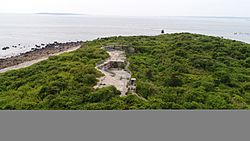Fort Mansfield facts for kids
Quick facts for kids Fort Mansfield |
|
|---|---|
| Part of Harbor Defenses of Long Island Sound | |
| Napatree Point, Westerly, Rhode Island | |

The remains of Fort Mansfield on Napatree Point.
|
|
|
Location in Rhode Island
|
|
| Coordinates | 41°18′23″N 71°53′05″W / 41.30639°N 71.88472°W |
| Type | Coastal Defense |
| Site information | |
| Owner | State of Rhode Island, public beach |
| Controlled by | Town of Westerly |
| Open to the public |
yes |
| Site history | |
| Built | 1901 |
| Built by | United States Army |
| In use | 1901-1917 |
| Battles/wars | none |
Fort Mansfield was an old military base built on Napatree Point. This long strip of land is located in Watch Hill, a village in Westerly, Rhode Island. The fort's main job was to protect the coast from enemy ships.
Contents
History of Coastal Defenses
Back in the late 1800s, leaders in the United States realized the country's coasts were not well protected. They worried about enemy ships attacking important harbors and cities. To fix this, the government created special groups, like the Endicott Board, to plan new defenses.
These groups recommended building many forts along the coast. Fort Mansfield was one of these new forts. It was part of a larger defense system for Long Island Sound. This system helped guard important cities like New York City.
The fort was named after Joseph K. Mansfield. He was an important engineer officer in the U.S. Army. He fought in the Mexican War and later became a general. Sadly, he was killed during the Civil War at the Battle of Antietam.
Building Fort Mansfield
In 1898, the United States government bought about 60 acres (240,000 m²) of land on Napatree Point. This area is a long, narrow piece of land that sticks out from Watch Hill. Construction of the fort began the very next year.
When the fort first opened in 1901, it was a smaller part of Fort Trumbull in New London, Connecticut. But by 1902, Fort Mansfield became its own independent base.
The fort had several large guns to protect the coast:
- Battery Wooster: This battery had two large 8-inch (203 mm) disappearing guns. A disappearing gun could pop up to fire and then lower itself back down. This hid the gun from enemy ships. Battery Wooster was named after David Wooster, a general from the Revolutionary War.
- Battery Crawford: This battery had two 5-inch (127 mm) guns. These guns were on special "balanced pillar" mounts. These mounts were supposed to retract, but they didn't work well and were kept in the "up" position. Battery Crawford was named for Emmet Crawford, an Army officer.
- Battery Connell: This battery also had two 5-inch (127 mm) guns. These were on "pedestal mounts," which means they sat on a fixed stand. Battery Connell was named for James W. Connell, another Army officer.
A Big Problem for the Fort
In 1907, the military held practice battles, called "war games," at Fort Mansfield. These games showed a serious problem with the fort's design. There was a "dead angle" along the Rhode Island coast. This meant enemy ships could approach the fort from a certain direction without being hit by its long-range guns.
A report from these war games said that an attacking fleet could easily bombard the fort without being harmed. It also said that an invading group could attack the fort with little resistance. One officer even joked, "I believe I could capture Ft. Mansfield with a fleet of coal barges, equipped with 6-inch rapid fire guns."
Because of this major design flaw, Fort Mansfield was taken off the list of active coastal defense posts in 1909. It was put into "caretaker status," meaning only a few people were left to look after it.
By 1911, only 18 soldiers remained at the fort. This number dropped to just six men by 1916. The fort's large guns were removed in 1917. They were sent to possibly be used in World War I on the Western Front. The small group of soldiers stayed until 1926. After that, the government decided to sell the land.
In 1928, a private group bought the land. They wanted to make sure the area stayed exclusive and wasn't developed with many small houses.
What Happened to the Fort?
During the winter of 1928–29, all the government buildings at Fort Mansfield were torn down. However, the three concrete gun emplacements were left behind.
Today, you can still see parts of Battery Wooster and Battery Crawford. They are overgrown with plants, but they remain. Sadly, Battery Connell has been lost to the ocean. The sea has eroded the beach, pushing it back about 200 feet (61 m) since the fort was built. Sometimes, if the tide is very low, you might still catch a glimpse of what's left of Battery Connell.
During World War II, there were plans for new, very large guns in the Watch Hill area. These were 16-inch guns, but they were never built. However, a battery of four 155 mm guns was placed nearby from 1942 to 1944.
Cleaning Up the Fort
In August 2009, a group of young adults who cared about history started a cleanup project at Fort Mansfield. They found that tree roots were causing a lot of cracks and damage to the fort's concrete. By cutting back the plants and roots, they helped slow down the fort's decay.
This cleanup project really helped the old fort. In 2011, the Watch Hill Fire Department added railings along the top edges of the main building. They also put steel covers over the steps. This prevents people from going down to the lower levels of the site, making it safer.


